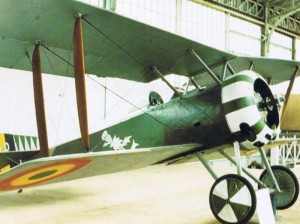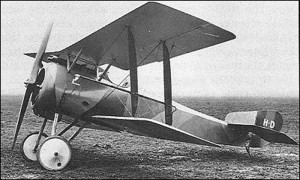The Hanriot HD.1 was a single-seat biplane fighter. Despite its development in 1916 by the French company Hanriot, the HD.1 was not adopted by the French squadrons, but equipped the Belgian and the Italian air forces. It was a highly successful design, piloted by WWI Aces such as Willy Coppens, Mario Fucini, and Silvio Scaroni.
While Hanriot began the 1900s developing several pre-war monoplanes, they had mainly produced licensed-production aircraft by the start of World War 1, most notably the Sopwith 1 1/2 Strutter. By April, 1916, the company had developed the Hanriot HD.1. The common version of the story relates the French government preferred the SPAD S.7, and released the new HD.1 fighter to the allies. According to a documental research of Gregory Alegi, an Italian aerospace journalist and historian, however, the Hanriot HD.1 didn't directly compete with the SPAD S.7, for French use, as the design was produced when the Nieuport 17 successor had been already chosen. Beyond that, Hanriot also made changes in the aircraft design, based on suggestions by Italian aces to tailor the machine to their needs.
The Hanriot HD.1 design proved light at the controls and nimble for its class, making it an excellent gunnery platform. Of a total of approximately 1,200 built, 831 were produced in Italy under license.
The design of the HD.1 was conventional for the day and bore some resemblance to the Sopwith 1 1/2 Strutter. The airframe design was light, yet sturdy, and sported clean lines, a circular front-end mounting the engine, and a slab-sided fuselage.
The engine was mounted in a forward compartment encased in metal and fitted a relatively average 110 horsepower Le Rhone 9J rotary engine and a large, two-bladed wooden propeller. The undercarriage was fixed in place and dominated by two single-wheeled main gear legs, supplemented by a basic wooden tail skid at the rear. The fuselage tapered off into the empennage which was capped with a rounded vertical tail fin and angular horizontal planes.
This aircraft was armed with a 7.7mm Vickers aerial machine gun, though a second could be fitted. Both were seated directly ahead of the pilot, allowing him to easily solve any possible jamming. The machine guns were tied to the propeller, thanks to an interrupter gear which allowed synchronized firing through the spinning blades.
The bulk of the early production of the Hanriot HD.1 was diverted to Belgians pilots, where the HD.1 proved surprisingly successful and was used for the rest of the war.
The HD.1 was also supplied in small numbers to the Italians who manufactured it in quantity, and used it to replace not only Nieuports, but also SPADs in their service. Italian aviation considered the HD.1 to be a better all-round fighter than even the SPAD S.XIII and it became the standard Italian fighter, equipped in 16 of the 18 operational Italian fighter squadrons by November 1918. After the war, Italian-built HD.1s were used by several countries, including Switzerland.
The U.S. Naval Aircraft Factory even built 10 HD.1s during the immediate postwar years, using them as trainers, and in experiments with takeoff platforms on warships.
In the next article, you will learn about the history and the pilots of the three Hanriot HD.1s presented in the WW1 Wings of Glory Airplane Packs.
Information sources: Wikipedia, Military Factory, Valka.cz, Le Ali della Memoria, The World at War, Pfarrout Graphics Inc., "Hanriot HD.1/HD.2" (Gregory Alegi, Windsock Datafile 92, March 2002).











